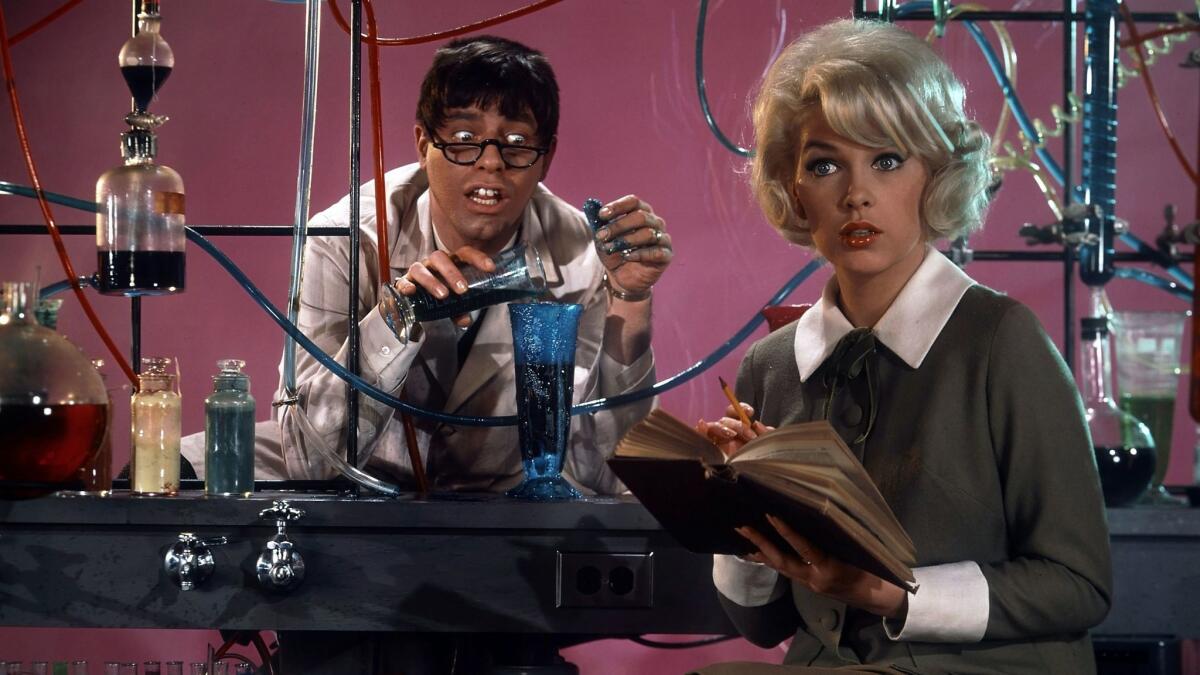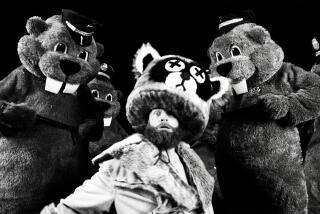Appreciation: Jerry Lewis, the movies’ mad and mercurial comic genius

Jerry Lewis didn’t just play a nutty professor. For years he reigned as a mad comic scientist of the screen — a brash innovator who exploded conventions and expectations on either side of the camera, and a take-no-prisoners farceur who mixed slapstick antics with a seething man-child persona of his own making.
Like dispatches from previously uncharted corners of the American id, his experiments could make us laugh, make us cringe or just leave us plain bewildered for reasons that critics and audiences have never stopped trying to get a handle on.
They are unlikely to stop anytime soon. The box-office glories and Labor Day telethons of Lewis’ heyday may have ended long before his death on Sunday at age 91, but his reputation has hardly settled or calcified into consensus. If anything, his is the rare legacy that feels both unassailable and worthy of continual reappraisal — as malleable, in its way, as his famously twitchy and elastic mug.
Lewis’ influences are wide-ranging and well cited. A partial list would include the comic traditions of burlesque and vaudeville, the looming specters of Charlie Chaplin and Jacques Tati, and his fabled collaborations with Dean Martin and Frank Tashlin. Remarkably, none of these relationships and inspirations can be said to have permanently defined him, much less anticipated his trajectory. Blurring the line between the hilarious and the mawkish, between the joyously lowbrow and the unexpectedly cerebral, his work was forever charging ahead and carving out bizarre new tributaries, as though governed by nothing more (or less) than his unruliest, most unpredictable psychological impulses.
The idea of comedians getting under the skin and tapping into their deepest, darkest selves is no longer especially novel, but it was far from a universally accepted notion when Lewis first took the spotlight. Few comedians before him had so brazenly turned arrested development into art, or held up such a warped fun house mirror to American identity in its loudest, ugliest, vulgarest excesses. Fewer still had advanced the still-radical notion that comedy doesn’t always have to be funny, just fearless, in order to strike a nerve.
Lewis’ star-making early routines with Martin, far from rehashing the dynamic of immortal duos like Abbott and Costello or Laurel and Hardy, reenergized the usual funnyman formula with a fresh mix of swinging music and anarchic nonsense. There was something unique about the two men’s palpable affection for each other, the sheer joy they seemed to take in performing in tandem and responding to each other’s wildly different rhythms.
It wasn’t long before the two shifted from radio and nightclub gigs toward television and eventually movies, starting with “My Friend Irma” (1949) and yielding a series of big hits including “That’s My Boy” (1951), “Sailor Beware” (1952) and “Living It Up” (1954). Martin may have anchored the lively proceedings with his straight-man suavity, but critics weren’t shy about opining that it was Lewis, the manically inspired cutup, who felt like the revelatory half of the duo.
The increasingly lopsided nature of their collaboration ultimately drove them apart, and whatever regrets the two men may have harbored — Lewis would share a few in his surprisingly candid 2005 memoir, “Dean & Me (A Love Story)” — it was far from the end of the road for either of them. Martin still had “Rio Bravo,” the Rat Pack and “The Dean Martin Show” to look forward to. Lewis was about to embark on a run of pictures, several of which he wrote and directed as well as starred in, that look ever more inventive, vital and weirdly original in retrospect.

The sensibility that Lewis displayed behind the camera went well beyond “make ’em laugh” (which was of course never an easy feat, even if he made it look that way). Who knew, at the time, that this peerless improv artist would also prove himself such a master of elaborate, exacting mise-en-scène? It helped that he worked with Tashlin, a Warner Bros. animation veteran whose live-action pictures — including the Martin and Lewis comedies “Artists and Models” (1955) and “Hollywood or Bust” (1956) — were often filled with bold, vibrant colors and surreal visual accents. Tashlin also directed a number of Lewis’ early solo screen efforts, including “Rock-a-Bye-Baby” (1958), “The Geisha Boy” (1958) and “CinderFella” (1960), an amusing reworking of the fairy tale.
Lewis’ work as a director borrowed plenty from Tashlin, mainly in its understanding that even the studio-comedy formula could be a vehicle for intensely personal filmmaking. His directing debut, “The Bellboy” (1960), was a plot-free, Tati-inflected black-and-white exercise that brilliantly defined the outsized Lewis persona in opposition to the anonymous, automaton-like nature of his character’s work.
His second film as a director, “The Ladies Man” (1961), reveled in the visual possibilities of its staggeringly complex, dollhouse-like set — not just a physical space but a psychological one as well, in which Lewis’ persona, with its infinite shades of cross-eyed sexual panic, is allowed to run gloriously free.
Not long afterward he directed “The Nutty Professor” (1963), which is widely regarded as his masterpiece. Starring Lewis as the nerdy, buck-toothed chemist Julius Kelp, who, infatuated with one of his students (Stella Stevens), uses the magic of science to transform into a smooth-talking lounge singer named Buddy Love, the movie is a remarkable piece of film craft. The bright cartoon colors and exaggerated sound effects have a weirdly totalizing effect; Lewis’ virtuoso Jekyll-and-Hyde act doesn’t exist in a vacuum, but feels entirely of a piece with the world the director has created. It’s as if the movie has already absorbed the central lesson — “You might as well like yourself” — that Kelp will ultimately have to learn.
There were many movies and a few highs still to come for Lewis, including his brilliantly somber performance as a late-night TV personality in Martin Scorsese’s “The King of Comedy” (1983), and a slew of lifetime achievement honors in the 2000s from organizations including the Academy of Motion Picture Arts and Sciences, which never nominated him for a competitive Oscar. There were daring efforts like “Smorgasbord” (1983), a.k.a. “Cracking Up,” Lewis’ final film as a director and, being a series of gags structured around suicide attempts, one of his least beholden to viewer expectations.
There was his notorious, never-released Holocaust drama, “The Day the Clown Cried” (1972), a 30-minute cut of which surfaced online last year. Starring Lewis as a circus clown thrown into a Nazi concentration camp for mocking Hitler, it’s perhaps the most extreme reminder that Lewis’ comedy could walk a perilously thin line between conceptual daring and shameless bathos, something that later, less controversial projects would continue to bear out.
In 2013 he attended the Cannes Film Festival with the melodrama “Max Rose,” which drew a standing ovation that testified less to the movie’s quality than to Lewis’ enduring popularity in France — a phenomenon tied to his genius as not just a comedian, but an auteur. The French of course have a long and storied tradition of rescuing major American directors (like Clint Eastwood) from the scandal of American indifference, though whether they really were the first ones to take Jerry Lewis seriously — still a matter of ongoing debate in some circles — matters far less than the fact that he is taken seriously, period.
“I need the applause,” Lewis could be heard to say appreciatively when audiences roared their approval. Maybe so, but we needed him more.
More to Read
Only good movies
Get the Indie Focus newsletter, Mark Olsen's weekly guide to the world of cinema.
You may occasionally receive promotional content from the Los Angeles Times.







